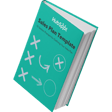
Amy, the head of sales operations, was cheery and laughed easily. She nodded enthusiastically as the rest of the sales leaders around the table discussed the final tweaks to the new sales compensation program.
As the meeting ended and everyone began to leave the room, I mentioned I thought the compensation plan was excellent.
“Sure, it’s a great plan,” Amy replied. “But it will never work because the sales leaders will send out an email and expect the sales teams to immediately understand it.”
“I’ve been here 17 years, and I’ve tried everything to improve communications and roll out,” she continued. “It’s too big a job for one person, and I’ve given up.”
Years ago, Amy had realized that a successful sales compensation program depended on clear communication -- yet she had been unable to convince the sales leaders to invest the time and effort necessary to properly roll it out. After months of working on the comp plan, they were tired and ready to be finished.
But communication is a crucial step in an effective sales compensation program. The organization is spending a significant amount time and money -- in fact, sales compensation is often one of the most expensive line items an organization will have. There’s an unfortunate temptation to send one email announcing the new plan and consider it done.
For a few exceptional salespeople, this is enough. For the rest, at best it’s a missed opportunity to connect the sales strategy to the sales comp plan. At worst, it’s an invitation to do what’s easiest rather than what’s best for the strategy.
Proper communication acknowledges that not all people learn in the same way. In fact, as Howard Gardner, the Hobbs Professor of Cognition and Education at the Harvard Graduate School of Education, proposed in "Frames of Mind: The Theory of Multiple Intelligences," there are at least seven distinct intelligences.
Effective communication incorporates all seven to reach the entire sales team. When developing your sales comp communication strategy, consider leveraging different communication methods.
How to Leverage the 7 Types of Intelligence
Linguistic intelligence
Some people prefer to capture information through language, both in writing and orally. They learn by reading, listening, and telling stories.
How to communicate the plan: Distribute a written explanation and and hold individual and group discussions.
Logical-mathematical intelligence
Some people are skilled at solving analytical problems and seeing relationships between objects. They’ll be the first to reverse engineer the new plan.
How to communicate the plan: Use plan calculators and examples. You should also draw clear comparisons to the former plan.
Visual intelligence
Some people can easily translate information to and from images and pictures.
How to communicate the plan: Create visual models of how the components work.
Kinesthetic intelligence
Some people absorb new information through touch, manipulation, and movement.
How to communicate the plan: Leverage demonstrations and roleplays of how the plan works.
Musical intelligence
Some people recognize tones, rhythms, and musical patterns. They can often remember and repeat a melody after listening it to once.
How to communicate the plan: Develop messaging and phrases to reinforce the plan. One client coined the term “55 to stay alive” to introduce a new program with a threshold of 55 products sold.
Interpersonal intelligence
Some people can connect with and influence others and are often natural leaders.
How to communicate the plan: Hold one-on-one and small group discussions and enlist the most influential reps as supporters of the plan in the field.
Intrapersonal intelligence
Some people are keenly aware of their strengths and weaknesses and have great self-discipline. They sometimes prefer to study individually.
How to communicate the plan: Craft messages about personal growth and give them time to absorb and process new information before following up.
Addressing each learning style doesn’t need to be complicated. Start slow, identify how your team members learn best, and encourage feedback. The more you communicate, the easier and more successful the roll out will be.



![Sales Incentives: How To Use Them To Motivate Reps [Data + Expert Insight]](https://53.fs1.hubspotusercontent-na1.net/hubfs/53/successful-sales-incentives.jpg)



![How to Diagnose & Solve 4 Major Sales Problems [SlideShare]](http://53.fs1.hubspotusercontent-na1.net/hubfs/53/00-Blog_Thinkstock_Images/diagnose-major-sales-problems.jpg)



